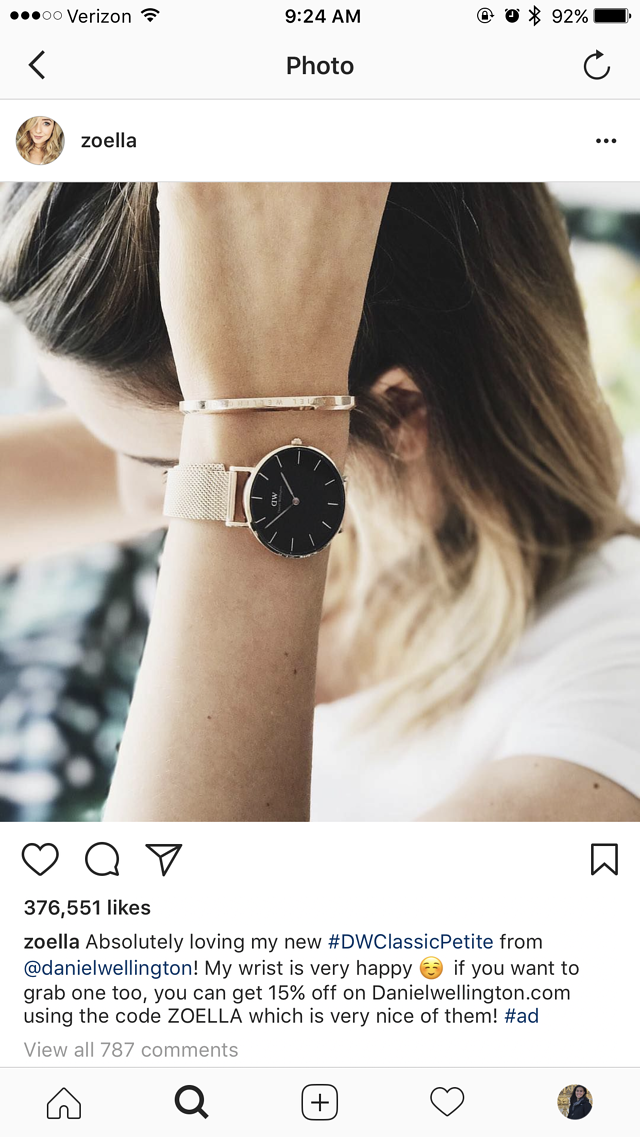//
Aug 23, 2017
Why are Instagram Influencers so Successful?
Imagine your instagram feed.
Most likely, it’s filled with pictures and videos from your family and friends. If you follow any celebrities or social media stars, you’ve likely seen a post of them posing candidly with a product. Their photo caption probably says something along the lines of “In love with my new [insert product name here] from [insert brand here]. Sound familiar? Allow me to introduce you to Instagram influencers.
Over the past year, influencer marketing has skyrocketed in popularity. No matter the brand or industry, businesses are to social media moguls to help promote their products and services online, increasing their reach tenfold. So how exactly are brand finding the perfect Instagram influencers, and why are they proving to be so successful?
WHAT IS INFLUENCER MARKETING?
Before diving into why influencers are so successful, let’s talk about what influencer marketing is. In a sense, it is the new celebrity endorsement, however, not all influencers are celebrities. In fact, many influencers are niche industry thought leaders, who’ve amassed large, dedicated followings on social media. You may have heard of them being referred to as “social media famous.”
Perhaps a better definition of influencer marketing is paid word-of-mouth, which indicates why influencer marketing works so well. Nearly of consumers said word-of-mouth recommendations are a key factor in their purchasing decisions. So how do brands pick the perfect influencer?
Through careful selection, brands and their marketing agencies hand-pick social media’s most successful accounts and pay them to promote their products in a more subtle way than advertisements and . More specifically, brands pay influencers to post photos with their products, so that the post doesn’t appear as a sponsored ad in followers’ feeds, but rather, as a less obvious, more natural-looking advertisement.
RELATED:
WHO ARE INSTAGRAM INFLUENCERS?
Influencers come in all shapes and sizes. Ultimately, the right person to promote your brand is someone that appeals to your target audience. Sometimes these are celebrities, but more often than not, these are individuals who have grown a social audience with their original content on social platforms. In fact, of consumers are more likely to buy something promoted by an influencer who isn’t a celebrity than products endorsed by celebrities (3%).

Many of these "non-celebrity" influencers are social media stars from Twitter, YouTube and Instagram. YouTube beauty expert, Zoella, for example, not only has a strong YouTube following, but she also has amassed 11.1 million followers on Instragram, which is why many beauty and fashion companies have reached out to her to create posts promoting their products.
Before you even begin looking at potential influencers on social media, you need to start with the most important people in your campaign–your consumers. You don’t need to just know your target audience; you need to know them well. If you don’t already, craft detailed to dive into your consumers’ shoes and understand their habits, likes and interests. This will help you discover what social platforms they are most active on and the accounts they follow.

Use your personas as a guide in your search for influencers. Look for individuals that are thought leaders and are someone your audience looks up to and admires. Take your time picking influencers, and remember it’s ok to be picky, especially when on average, businesses earn for every $1 they invest in influencer marketers.
RELATED:
WHY IT WORKS BETTER THAN TRADITIONAL ADS
Like most successful advertising, influencer marketing works because consumers are “opting in” rather than having content they didn’t ask for shoved in their faces. While they’re not necessarily opting in to your marketing, they are opting in to receive the content posted on the social media accounts they follow. Not to mention that consumers follow influencers’ social accounts because they like them and trust the information they provide.
So why does this work from a marketing standpoint? Simply put, your audience is already engaged with the marketing channel. Consumers are getting on social platforms to see what their favorite accounts are posting. Furthermore, while having an influencer post your product on their account, it doesn’t just increase your reach. Rather, it creates an association between your brand and the influencer in a more natural way.
In fact, the best influencer marketing posts are those that don’t seem like ads at all. Instead, these posts blend in with the Instagram influencers’ brand and don’t seem out of the norm. However, this is where issues can arise in terms of advertising legality.
THEY LEGAL GREY AREA
As marketers and business owners, you have to be aware of the people seeing your marketing content and the message it portrays. With that, if you want to maintain brand loyalty, you’ve got to follow through on the image your marketing develops and any promises it makes. Perhaps the most notorious influencer marketing fiasco is the , where influencers promoted a lavish music festival, but when festival goers arrived they found nothing of the sort.
As influencer marketing has grown in popularity, so have the number of accusations of deceptive advertising. It began when advocacy group Public Citizen launched an into whether or not Instagram influencers and those on other social media sites were violating Federal Trade Commission (FTC) guidelines in 2016.
At this point, many influencer posts included hashtags, such as #partner or #sp, meant to stand for “sponsored.” Some simply stated “Thanks [Brand X].” This, anti-influencers said, didn’t express clearly enough that the influencer was paid for the post. To combat the grey area influencer marketing had entered, The stating that:
- Any endorsements or posts, where a person is paid to promote a product, must “clearly and conspicuously” disclose any connections to the product (e.g., payment, free product, any family/business relationships, etc.)
- Disclosures of brands sponsoring the posts should be made towards the beginning of the caption or photo description, such as “Brand X gave me this product to try…”
- In addition to disclosing the endorsement, influencers may also include #ad to indicate the post is an advertisement

Photo courtesy of Bloomberg Technology
Earlier this year, Instagram also announced they would start by adding “Paid partnership with [brand X]” underneath the account’s name in the post. This would this make it more clear that the influencer account was paid to post, and it would put it in a place where it could be seen easily.
THE MORAL OF THE STORY
Like any marketing trend, it’s important to think of the end user. Consider how your consumers will view an influencer post, and whether or not the message is promoting and informing consumers in an ethical way and in the way you want the message to come across.
The bigger picture shows that digital media is growing. Not to say traditional advertising is dying (Spoiler: ). It is becoming an absolute necessity to move brands online, optimize websites and engage audiences on social platforms. If you’re not doing it yet, you’re already behind. Ultimately, when it comes to organizing an Instagram influencer campaign, be a smart marketer, think of the end consumer and always stay true to your brand.







